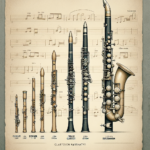The A# Whole-Tone Scale: A Unique Musical Journey
The A# Whole-Tone scale in clarinet music has a fascinating background that many musicians might not fully appreciate. Emerging in the late 19th century and gaining popularity into the 20th, this scale changed how composers and performers approached music composition and improvisation. If you've played a clarinet, you've likely experienced the thrill of those high notes that seem to float in the air. The A# Whole-Tone scale captures this ethereal quality, transforming melodies in unexpected ways.

Clarinet Fingering Charts are always FREE at MartinFreres.net!
Characteristics of the Whole-Tone Scale
The Whole-Tone scale stands out because it's made up entirely of whole steps. This structure gives it a dreamy, ambiguous feel. While traditional scales often evoke specific emotions—minor scales sounding melancholic, for instance—the Whole-Tone scale plays with perception. It dances between moods, allowing listeners to form their own interpretations. For clarinetists, this opens up a world of melodic exploration.
Historical Roots and Influential Composers
We can trace the A# Whole-Tone scale's roots to works by composers like Claude Debussy and Maurice Ravel. These musical innovators highlighted the scale in their pieces, inspiring clarinetists to approach music with fresh eyes and a spirit of innovation. Debussy's use of this scale mirrored the impressionistic movement of the early 20th century, blending harmonic exploration with fluid melodies.
| Composer | Period | Notable Works Using Whole-Tone Scale |
|---|---|---|
| Claude Debussy | Impressionist | “Voiles” from Préludes, Book I |
| Maurice Ravel | Impressionist | “Jeux d'eau” |
| Béla Bartók | 20th Century | “The Miraculous Mandarin” |
Expanding Across Genres
As clarinetists became more familiar with the Whole-Tone scale, its use spread across various musical styles. It's particularly prevalent in jazz and contemporary music, where musicians often seek unique sounds. If you're feeling adventurous, why not give it a try? You might discover new sounds you never knew you could create!
Famous Clarinetists and Their Techniques
Renowned clarinetists like Benny Goodman and Woody Herman blended traditional and modern techniques in their performances, often drawing from the A# Whole-Tone scale. Their improvisations take listeners on thrilling musical journeys, showcasing the scale's versatility in storytelling. Listening to these masters glide through notes feels like eavesdropping on an intimate conversation, full of twists and turns.
Constructing the A# Whole-Tone Scale
When you play the A# Whole-Tone scale, you'll use the notes A#, B#, C#, D#, E#, F#, and G#. While it might seem restrictive compared to other scales, this limited set of notes actually opens up endless possibilities for exploration. Each note flows smoothly into the next, allowing you to experiment freely without worrying about hitting a wrong note. The result? A soothing, continuous flow of music.
A# Whole-Tone Scale Diagram
A# - B# - C# - D# - E# - F# - G# - (A#) | | | | | | | W W W W W W W
W = Whole step
Inspiring Musical Collaboration
The A# Whole-Tone scale often sparks collaboration among musicians. In ensembles and bands, when clarinetists use this scale, it often encourages other instruments to echo its harmonies. This creates a rich layer of sound that goes beyond individual performances. The scale pushes musicians to try new things, share ideas, and work together to create dreamy soundscapes that can elevate any performance.
Educational Value for Beginners
In music education, the A# Whole-Tone scale serves as an engaging introduction to improvisation. Beginners often find satisfaction in playing something that sounds complex while appreciating the scale's simplicity. Practicing with the Whole-Tone scale can help new clarinetists feel more comfortable with improvisation, making it less intimidating.
Incorporating the Scale into Your Practice
Looking to add the Whole-Tone scale to your practice routine? Try using it for warm-ups or in your practice pieces. Spend a few minutes exploring its patterns and shapes, and you might find new ways to express yourself musically. Why not try improvising a short melody using just this scale? You might surprise yourself with the strengths you discover in your musical voice.
The Lasting Impact on Clarinet Music
The A# Whole-Tone scale has left an indelible mark on the history of clarinet music. Its influence continues to shape new generations of players and composers, encouraging artistic growth and exploration. It connects musicians across time and genre, reminding us that music is a journey of continuous learning and discovery. So pick up your clarinet, dive into that scale, and see where the music takes you!
Table of Contents
- The A# Whole-Tone Scale: A Unique Musical Journey
- Characteristics of the Whole-Tone Scale
- Historical Roots and Influential Composers
- Expanding Across Genres
- Famous Clarinetists and Their Techniques
- Constructing the A# Whole-Tone Scale
- Inspiring Musical Collaboration
- Educational Value for Beginners
- Incorporating the Scale into Your Practice
- The Lasting Impact on Clarinet Music








